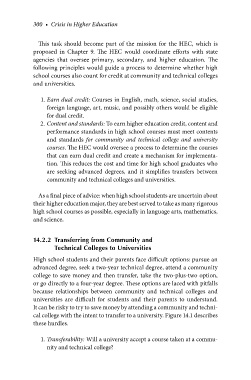Page 330 - Crisis in Higher Education
P. 330
300 • Crisis in Higher Education
This task should become part of the mission for the HEC, which is
proposed in Chapter 9. The HEC would coordinate efforts with state
agencies that oversee primary, secondary, and higher education. The
following principles would guide a process to determine whether high
school courses also count for credit at community and technical colleges
and universities.
1. Earn dual credit: Courses in English, math, science, social studies,
foreign language, art, music, and possibly others would be eligible
for dual credit.
2. Content and standards: To earn higher education credit, content and
performance standards in high school courses must meet contents
and standards for community and technical college and university
courses. The HEC would oversee a process to determine the courses
that can earn dual credit and create a mechanism for implementa-
tion. This reduces the cost and time for high school graduates who
are seeking advanced degrees, and it simplifies transfers between
community and technical colleges and universities.
As a final piece of advice: when high school students are uncertain about
their higher education major, they are best served to take as many rigorous
high school courses as possible, especially in language arts, mathematics,
and science.
14.2.2 Transferring from Community and
Technical Colleges to Universities
High school students and their parents face difficult options: pursue an
advanced degree, seek a two-year technical degree, attend a community
college to save money and then transfer, take the two-plus-two option,
or go directly to a four-year degree. These options are laced with pitfalls
because relationships between community and technical colleges and
universities are difficult for students and their parents to understand.
It can be risky to try to save money by attending a community and techni-
cal college with the intent to transfer to a university. Figure 14.1 describes
these hurdles.
1. Transferability: Will a university accept a course taken at a commu-
nity and technical college?

